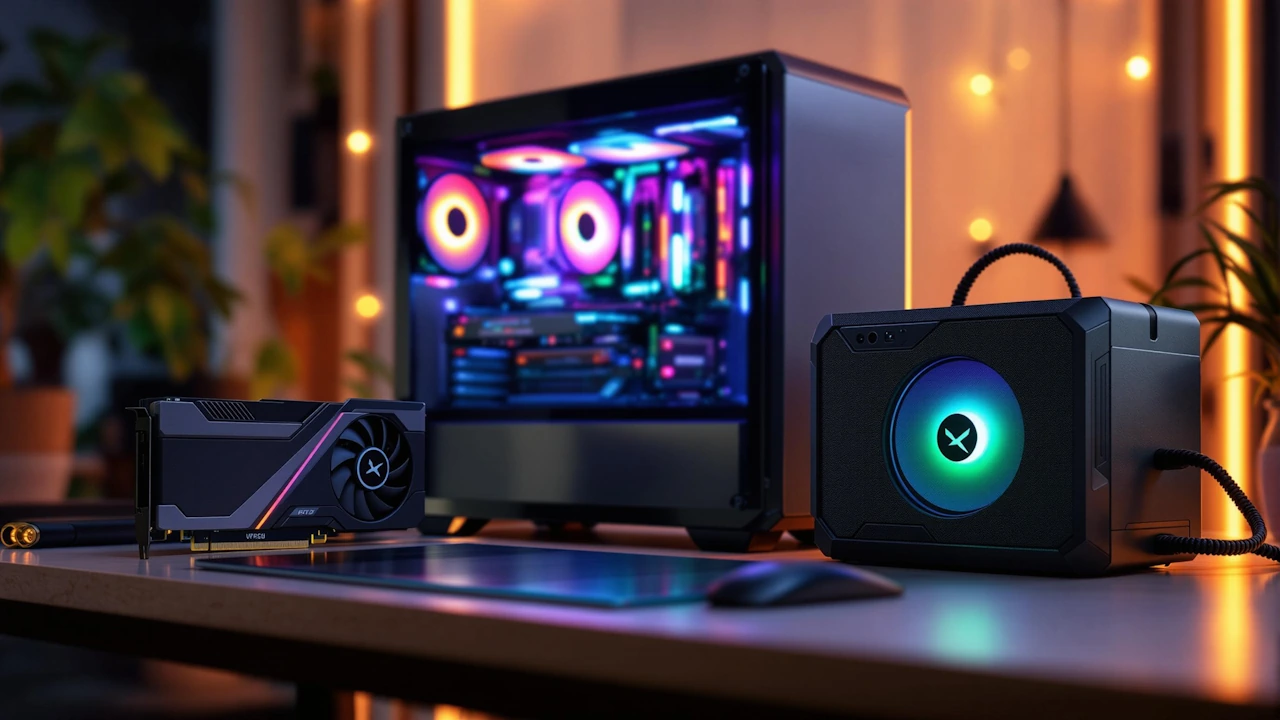Gaming PC Solutions
Custom Gaming PC Build: Essential Components Checklist
Custom Gaming PC Build: Essential Components Checklist
Building your own gaming PC in 2025 saves money and gives you full control over performance. Here’s what you need:
- CPU: At least 6 cores, 12 threads, and 3.5–4.0 GHz speed.
- GPU: Aim for 12GB VRAM or more for modern games.
- Motherboard: Match your CPU socket (e.g., LGA 1700 for Intel, AM5 for AMD).
- RAM: 16GB minimum; 32GB recommended for future-proofing.
- Storage: Use a fast NVMe SSD (1TB+) and a budget-friendly HDD for extra space.
- PSU: Reliable unit with 80 Plus Gold certification; 650W–850W capacity.
- Cooling: Air or liquid cooling based on your budget and performance needs.
- Case: Ensure proper airflow and compatibility with your components.
Quick Tip: Compatibility is key – double-check sockets, power requirements, and dimensions. Use this checklist for a smooth build process and optimal gaming performance.
How to Pick the Best PC Parts
Required PC Components
Building a gaming PC means carefully selecting components that work together for top-tier performance.
The CPU acts as the brain, processing game and software instructions. When choosing one, focus on its core count, clock speed, and cache size, as these directly affect how well games run.
GPUs come with dedicated VRAM and features like ray tracing, which enhance graphics in demanding games.
The motherboard connects all your components. As Intel puts it:
"Building a gaming PC from scratch is the only surefire way to ensure that your system is capable of satisfying all of your personal preferences." [2]
When it comes to memory (RAM), make sure it’s compatible with your motherboard. While 16GB is the baseline for 2024, opting for 32GB offers more flexibility for future needs [1]. Also, ensure the RAM type, such as DDR4 or DDR5, matches your motherboard specs.
For storage, you’ll need a mix of speed and capacity. NVMe SSDs are the fastest [1] – perfect for your operating system and most-played games. HDDs, on the other hand, are a budget-friendly option for additional storage.
A reliable power supply unit (PSU) is essential to keep everything running smoothly. Look for a trusted brand and ensure the wattage is sufficient for all your components with some extra headroom.
Your computer case should fit your motherboard’s form factor and provide good airflow. Cases with mesh fronts and multiple fan slots help keep temperatures in check.
| Cooling Type | Advantages | Best For |
|---|---|---|
| Air Cooling | Affordable, simple to maintain | Budget setups, moderate use |
| Liquid Cooling | Superior cooling, quieter operation | High-performance builds, overclocking |
Lastly, check that all components are compatible. For instance, Intel CPUs often use sockets like LGA 1700, while AMD Ryzen processors are designed for AM4 or AM5 sockets [3].
Component Selection Guide
Here’s a closer look at how to pick the right parts for your build.
CPU Selection
Choose a CPU with a solid balance of core count, thread count, and clock speed. For gaming in 2025, aim for processors with at least 6 cores and 12 threads, running at clock speeds between 3.5 to 4.0 GHz [2][4].
Here are two popular options:
| CPU Brand | Latest Socket | Strengths | Best Use |
|---|---|---|---|
| Intel | LGA 1700 | Excellent single-core performance | Competitive gaming |
| AMD | AM5 | Great price-to-performance ratio | Gaming and content creation |
Once you’ve selected a CPU, make sure to pair it with a compatible motherboard to unlock all its features.
Motherboard Selection
Your motherboard choice depends on the CPU socket, chipset, and BIOS compatibility. For Intel’s 12th/13th gen processors, go with an LGA 1700 motherboard featuring chipsets like Z690 or Z790 [3].
Key features to look for:
- Form factor: ATX for larger builds, mATX for compact setups.
- Memory support: Decide between DDR4 and DDR5 based on your budget and performance needs.
- Expansion slots: PCIe 4.0/5.0 for modern GPUs.
- Storage interfaces: Multiple M.2 slots for NVMe SSDs.
RAM Requirements
For gaming in 2025, 16GB is the minimum, but 32GB offers better performance for demanding tasks [2]. When picking RAM, consider:
- Speed: DDR4-3200 or DDR5-5200 as a baseline.
- Latency: Lower CAS latency means better responsiveness.
- Compatibility: Check that the RAM matches your motherboard’s supported DDR generation.
Storage Options
A dual-storage setup works best for modern gaming PCs:
| Storage Type | Suggested Capacity | Use Case |
|---|---|---|
| NVMe SSD | 1TB or more | Operating system and frequently used games |
| SATA SSD/HDD | 2TB or more | Storing your game library and media files |
This combination ensures fast load times and ample storage space.
GPU Choice
Your graphics card is the heart of gaming performance. High-end GPUs like the GeForce RTX 4090 deliver 24GB GDDR6X memory and 1008GB/s bandwidth [5]. For a more budget-friendly option, the RTX 4080 Super offers 16GB GDDR6X memory at 736GB/s bandwidth [5]. To stay ahead of future demands, aim for GPUs with at least 12GB VRAM [6].
Power Supply Selection
Calculate your system’s power needs and add 20% extra capacity for safety [2]. Look for these features in a PSU:
- 80 Plus Gold certification or higher for efficiency.
- Modular cables for easier cable management.
- 650W–850W capacity for mid- to high-end builds.
- Built-in over-voltage protection for reliability.
Cooling Setup
Pick a cooling solution that matches your CPU’s heat output, especially if you plan to overclock [4]. Options include:
- Air cooling: Affordable and effective for most builds.
- All-in-one liquid cooling: Quieter and better for higher thermal loads.
- Custom loops: Ideal for enthusiasts seeking top-tier performance and aesthetics.
Each cooling type has its pros and cons, so choose based on your performance and noise preferences.
sbb-itb-3b11325
Setup Requirements
Adding the right peripherals and tools not only completes your build but also makes assembly easier and prepares your system for future upgrades.
Gaming Peripherals
Once you’ve chosen your main components, it’s time to pick high-quality peripherals to level up your gaming experience.
| Peripheral Type | Recommended Model | Key Features | Price Range |
|---|---|---|---|
| Gaming Monitor | LG UltraGear 34GP950G-B | 1440p resolution, 21:9 aspect ratio, 144Hz refresh rate | £800–£900 |
| Gaming Headset | SteelSeries Arctis Nova Pro Wireless | Hot-swappable battery, 18–22 hours of battery life | £350–£400 |
| Gaming Keyboard | Razer BlackWidow V4 Pro | Mechanical switches, programmable dial | £220–£250 |
| Gaming Mouse | Asus ROG Keris II Ace | Lightweight design, high polling rate | £70–£90 |
Build Tools
To make assembly smoother, you’ll need the right tools. A magnetic Phillips #2 screwdriver, magnetic screw tray, and hex driver for standoffs are must-haves. A headlamp, like the PETZL TIKKINA, is perfect for lighting up those hard-to-see spots inside your case. Keep screws organized with a pill case, and always work in a static-free area to protect your components. Don’t forget to ground yourself before starting!
Upgrade Planning
After finishing your build, think ahead about upgrades to keep your system performing well over time.
| Component | Upgrade Consideration | Recommended Choice |
|---|---|---|
| Motherboard | Latest socket support | ASUS ROG Maximum Z790 Hero (£571) |
| RAM | DDR5 compatibility | Crucial 64GB DDR5 Kit (£144) |
| Power Supply | Higher wattage capacity | 850W or higher to support future GPUs |
| Storage | PCIe Gen 4/5 support | NVMe SSD with 2TB or more capacity |
When upgrading, focus on parts that boost performance now and leave room for future improvements. For example, the AMD Ryzen 7 7800X3D (around £398) delivers excellent gaming performance. Need more storage for your game library? The Western Digital WD_Black P40 Game Drive offers 1TB with read speeds up to 2,000MB/s, making it a great choice for fast and reliable storage.
Quick Reference List
Here’s a streamlined summary based on our component selection and setup guides:
| Component Category | Key Requirements |
|---|---|
| CPU | Ensure the CPU socket and BIOS are compatible with your motherboard. |
| Motherboard | Check for matching CPU socket, chipset, and PCIe standards. |
| RAM | At least 16GB; confirm support for DDR4 or DDR5. |
| Storage | Use a primary NVMe SSD (500GB or more); add SSD or HDD for extra storage. |
| GPU | Confirm PCIe compatibility and check power needs. |
| Power Supply | Choose a unit with enough wattage and an 80+ certification. |
| Cooling System | Opt for air or liquid cooling, ensuring proper airflow within the case. |
Essential Build Tools
- Magnetic #2 Phillips screwdriver
- Magnetic screw tray or small-parts organizer
- Hex nut driver or adjustable wrench
- Anti-static wrist strap
- Headlamp or flashlight
- Thermal paste
- Cable ties
"Building your own PC offers the advantages of personal customization, cost-effectiveness, higher performance, upgradeability, and valuable learning experience." – CORSAIR [7]
Key Compatibility Checks
- Ensure the CPU socket matches the motherboard.
- Review the motherboard’s CPU Support List.
- Confirm RAM type and speed compatibility.
- Check the motherboard’s Memory QVL (Qualified Vendor List).
- Calculate total power requirements.
- Verify case dimensions to ensure all components fit properly.
Performance Tips
- Update the BIOS before the first boot.
- Install the latest GPU drivers.
- Organize cables to improve airflow and cooling.
This summary highlights the essentials from our detailed guides. For more in-depth instructions, refer to the specific sections above.
Final Steps
Now that everything is installed and configured, it’s time to wrap up your build with these crucial steps.
Before powering on, take a moment to double-check everything. As NZXT wisely advises:
"A good once-over never hurt anyone; in fact, there’s a good chance that a quick once-over could prevent boot issues or component damage" [8].
Physical Connections and Safety
Go through all connections to ensure they’re secure. Check that the 24‑pin and 8‑pin connectors are firmly seated, the GPU is properly mounted in its PCIe slot, and the M.2 drives and RAM are fully inserted [8].
BIOS Configuration for Gaming Performance
Once your system boots, tweak these BIOS settings for better performance:
| Setting Category | Recommended Configuration |
|---|---|
| Memory Performance | Enable XMP in the AI Tweaker section |
| Graphics | Set GPU as the primary display adapter |
| Power Management | Switch to High Performance mode |
| AMD Systems | Turn on Smart Access Memory (SAM) |
| System Cooling | Set up custom fan curves |
Improved cooling also starts with tidier cable management.
Airflow Optimization
Route cables neatly behind the motherboard tray and secure them with ties. This keeps airflow unobstructed, which is critical for maintaining low temperatures [9].
System Stability
To ensure everything runs smoothly, update your GPU drivers, CPU microcode, and motherboard firmware. Monitor system temperatures and close unnecessary background apps for optimal performance [10]. These steps will help you achieve a stable and high-performing gaming setup.

